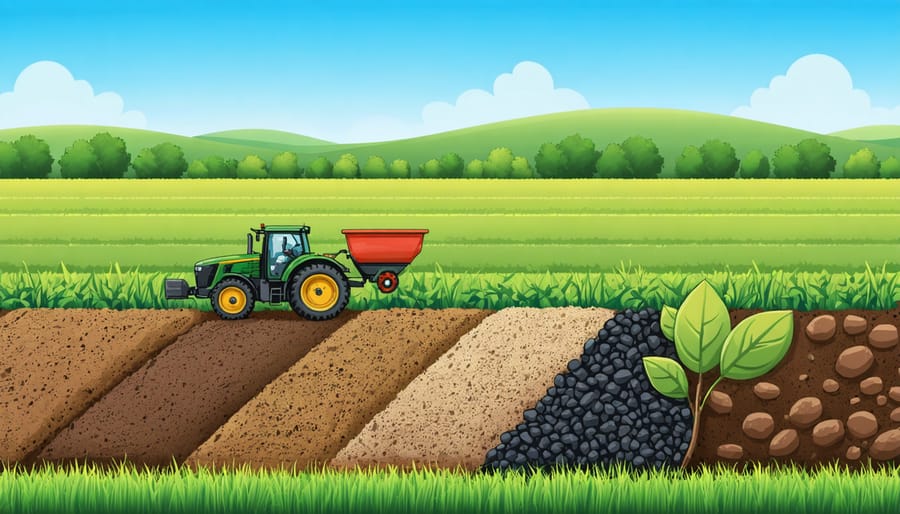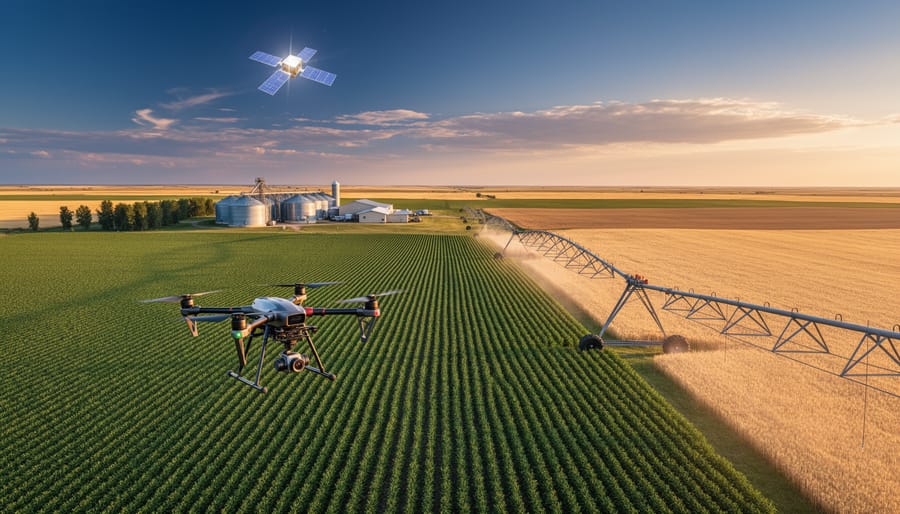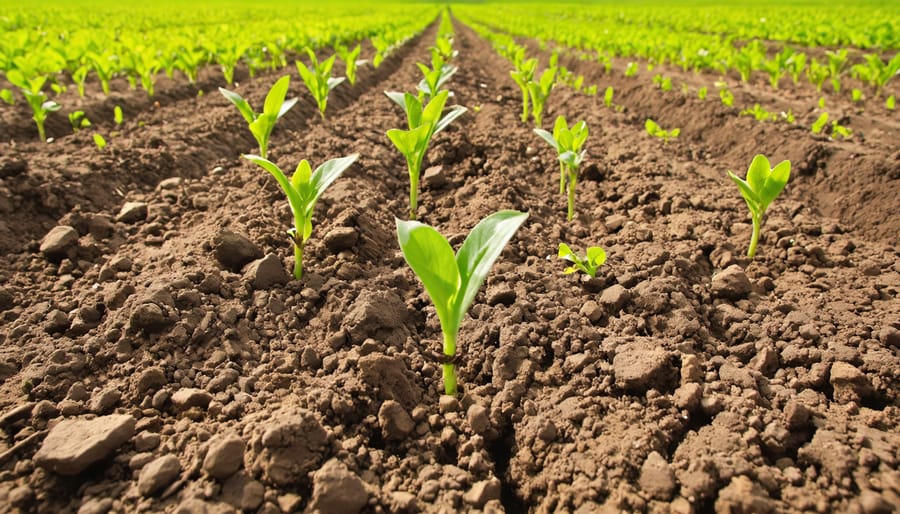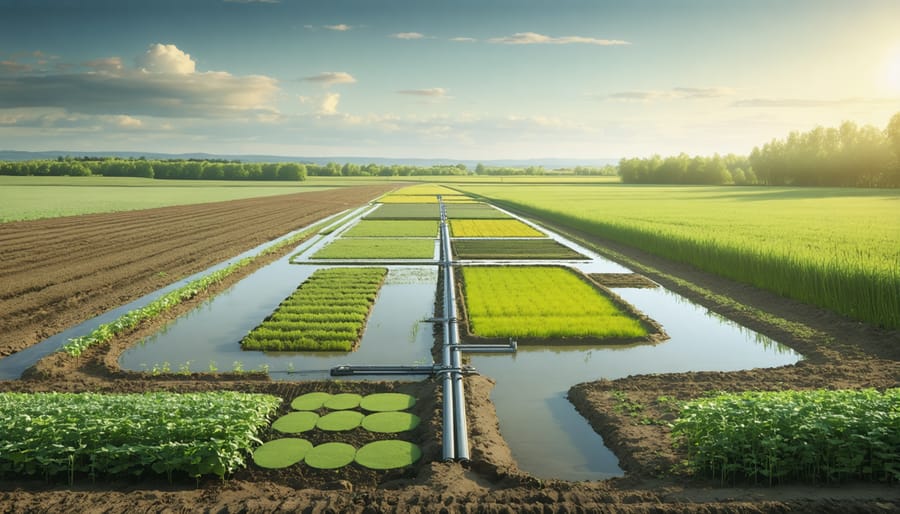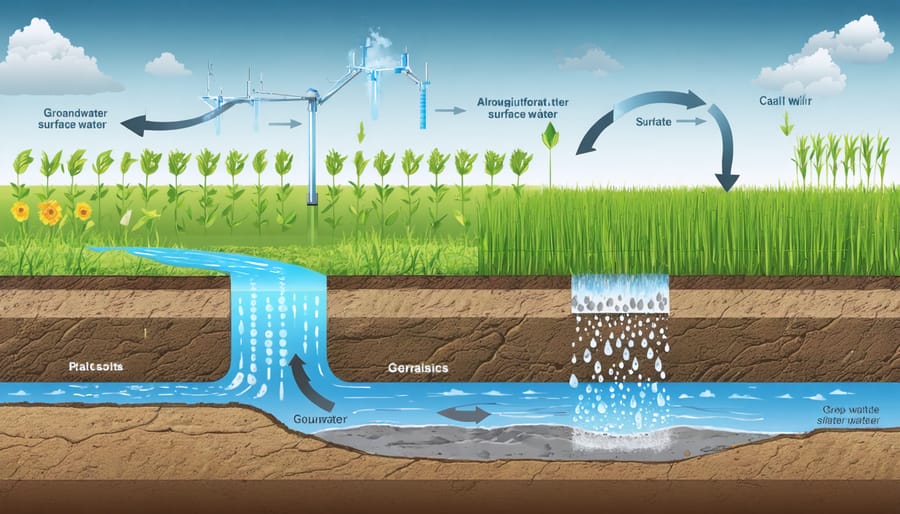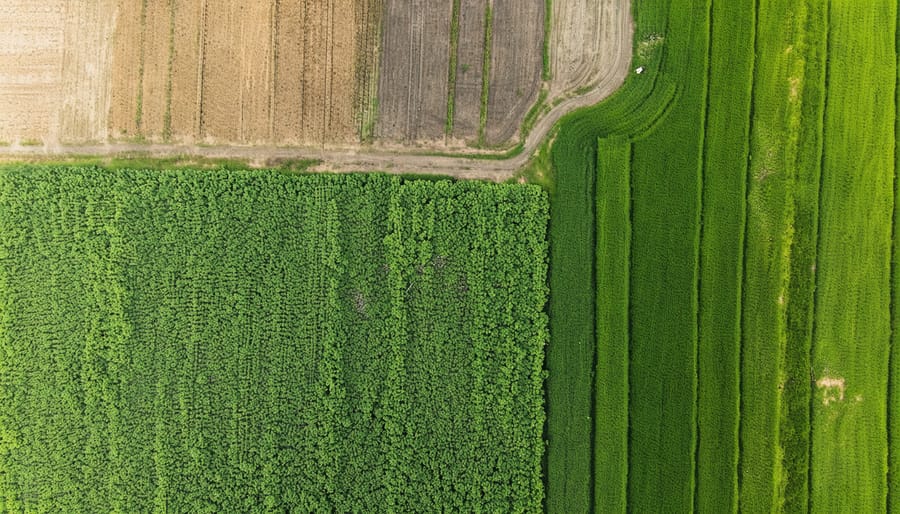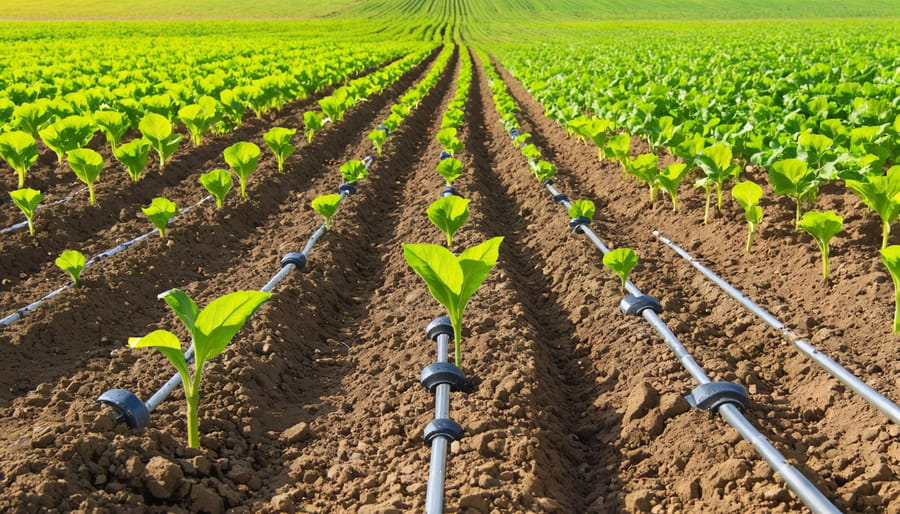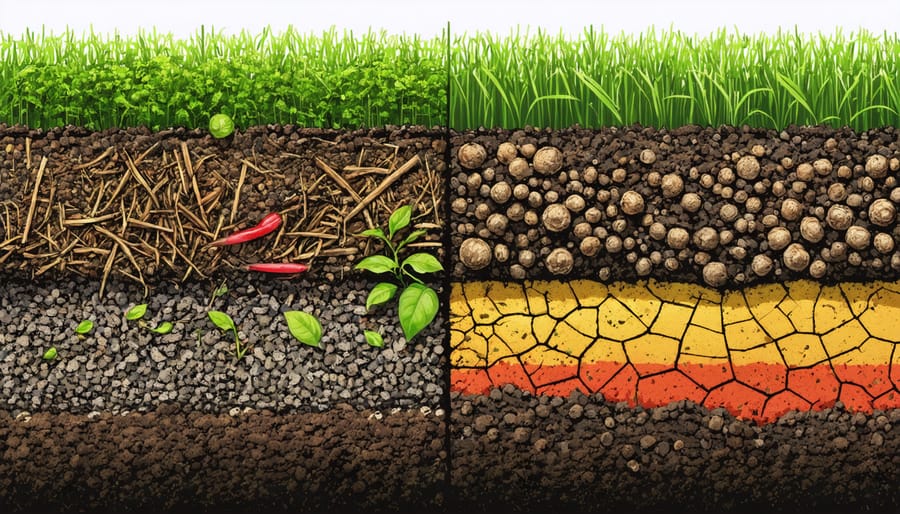Optimize biochar application rates by matching soil type and crop requirements – typically 5-10 tonnes per hectare for Alberta’s Prairie soils delivers maximum benefit while remaining cost-effective. Mix biochar thoroughly into the top 15-20 cm of soil during pre-seeding operations, incorporating it gradually over multiple seasons to minimize soil disruption. Monitor moisture retention improvements by measuring soil water content before and after application, with most Alberta farmers reporting 20-30% increased water holding capacity within the first growing season.
Field trials across central Alberta demonstrate that heavy clay soils benefit from lower application rates (3-5 tonnes/ha), while sandy soils show dramatic improvements with rates up to 15 tonnes/ha. Start with test plots of 1-2 hectares to evaluate biochar’s performance on your specific soil type before scaling up. Partner with local agricultural extension services to analyze soil samples and adjust application rates based on organic matter content, pH levels, and existing nutrient profiles.
This science-backed approach to biochar application has helped Prairie farmers reduce irrigation needs by up to 25% while improving drought resilience and soil structure – benefits that compound with each growing season.
Understanding Biochar Application Rates
Factors Affecting Application Rates
Several key factors influence biochar application rates in Alberta’s diverse agricultural landscape. Our soil types, ranging from Black Chernozemic to Gray Luvisolic, each require different approaches. Generally, heavier clay soils benefit from higher application rates (15-20 tonnes per hectare) to improve structure and soil moisture retention, while sandy soils may need lower rates (8-12 tonnes per hectare) to achieve similar benefits.
Alberta’s climate zones significantly impact application decisions. In drier regions like the southeastern prairies, higher rates can help retain precious moisture, while in areas with higher rainfall, moderate applications suffice. The length of our growing season also affects timing – spring applications are typically most effective, allowing the biochar to integrate before seeding.
Crop requirements play a crucial role too. Root vegetables and cereals often show the best response to moderate applications (10-15 tonnes per hectare), while legumes may benefit from slightly lower rates. Local success stories, like those from Leduc County farms, demonstrate how matching application rates to specific crops has led to yield improvements of 15-25% over three seasons.
Consider your soil’s existing organic matter content and pH levels when determining rates. Recent soil tests can guide these decisions, ensuring you’re not over-applying in already carbon-rich soils.
Measuring and Calculating Rates
To calculate biochar application rates, start by measuring your field area in square metres. A basic rate for Alberta soils ranges from 5 to 20 tonnes per hectare. For smaller plots, convert this to 0.5-2 kg per square metre. Use a standard kitchen scale for small areas or a livestock scale for larger quantities.
For accurate distribution, divide your field into equal sections using measuring tape or step counting. Pre-weigh biochar portions for each section to ensure even coverage. When mixing with existing soil, incorporate biochar to a depth of 10-15 cm, using standard tillage equipment or hand tools for smaller areas.
Remember to record your application rates and GPS coordinates if possible. This helps track results and adjust future applications based on soil response. Local soil testing labs can help determine optimal rates for your specific situation.
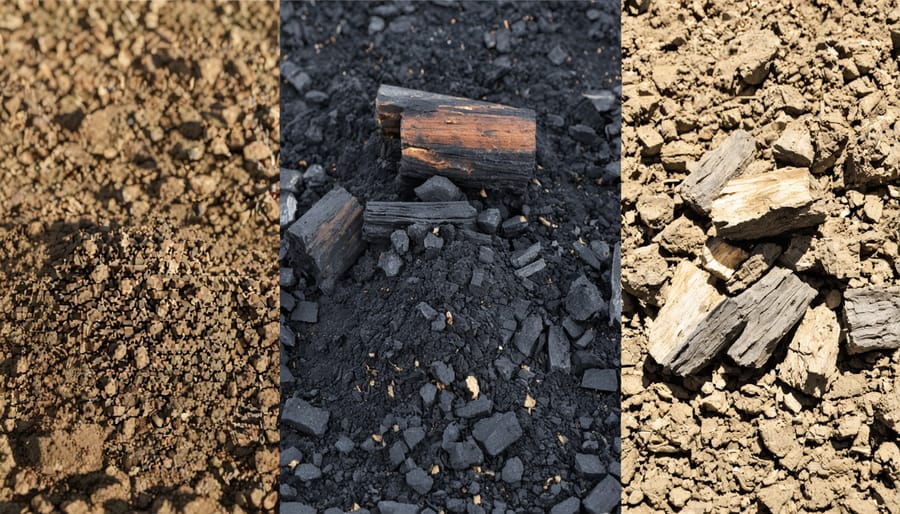
Optimal Application Rates for Prairie Soils
Clay Soil Applications
Clay soils in Alberta present unique challenges that require specific biochar application strategies. For optimal soil structure improvement, we recommend an initial application rate of 10-15 tonnes per hectare incorporated into the top 15-20 cm of soil.
Local farmers have found success using a two-phase approach: first applying 60% of the total biochar in fall during primary tillage, followed by the remaining 40% in spring before seeding. This method allows for better integration and prevents surface crusting common in heavy clay soils.
For established fields, consider incorporating biochar at 5-8 tonnes per hectare annually over three years rather than a single heavy application. This gradual approach helps maintain soil stability while improving drainage and aeration. Several Alberta farmers report that mixing biochar with compost or manure (1:1 ratio) before application enhances its effectiveness in clay soils.
Remember to adjust these rates based on your specific soil test results and crop rotation plans. Working with your local agronomist can help fine-tune these recommendations for your particular situation.
Sandy Soil Applications
Sandy soils in Alberta often benefit from higher biochar application rates due to their natural limitations in water retention and nutrient holding capacity. For these lighter soils, we recommend starting with 10-15 tonnes per hectare, which typically translates to a 2-3% addition by volume in the top 15 cm of soil.
Local farmers have reported significant improvements in moisture retention when applying these rates, with some noting up to 30% reduction in irrigation needs during dry spells. The key is incorporating biochar gradually over 2-3 seasons rather than all at once, allowing the soil ecosystem to adjust and maximize benefits.
For market gardens and smaller plots, aim for 1-1.5 kg per square metre. Pre-charging your biochar with compost tea or liquid fertilizers before application can jumpstart its effectiveness in sandy soils. Several farmers near Brooks, Alberta, have successfully used this method, reporting improved germination rates and more consistent soil moisture levels throughout the growing season.
Remember to monitor soil moisture levels regularly after application, as biochar can significantly change your soil’s water holding patterns, potentially requiring adjustments to your irrigation schedule.
Loam Soil Applications
For loam soils common across Alberta’s agricultural regions, apply biochar at a rate of 10-20 tonnes per hectare. This balanced soil type responds well to moderate application rates, making it ideal for first-time biochar users. Mix the biochar into the top 15-20 cm of soil during spring preparation or fall tillage for best results.
Many Prairie farmers have found success starting with 15 tonnes per hectare in their loam fields, adjusting future applications based on soil test results. Remember that loam’s natural balance of sand, silt, and clay particles means you won’t need as much biochar as with sandy or clay-heavy soils.
For market gardens and smaller plots, aim for 1-2 kg per square metre. Local success stories show that these rates improve both water retention and nutrient availability while maintaining soil structure.
Application Methods and Timing
Seasonal Application Windows
In Alberta’s climate, timing your biochar application is crucial for maximizing its benefits. Spring application, typically from late April to early May, allows the biochar to integrate with the soil during spring moisture conditions and before seeding. This timing aligns well with other regenerative farming practices and helps optimize water retention during the growing season.
Fall application, from mid-September to early October after harvest, provides time for biochar to weather through winter freeze-thaw cycles, improving its integration into the soil structure. This timing also allows for better workload management during the busy growing season.
Avoid applying biochar during mid-summer (July-August) when soil conditions are typically dry, as this can lead to wind erosion and reduced effectiveness. Similarly, application during spring thaw (March) or heavy fall rains (late October) can create challenges with field access and uniform distribution.
For best results, coordinate biochar application with your regular soil amendment schedule and consider splitting the total application rate between spring and fall to minimize operational impact while maximizing benefits.
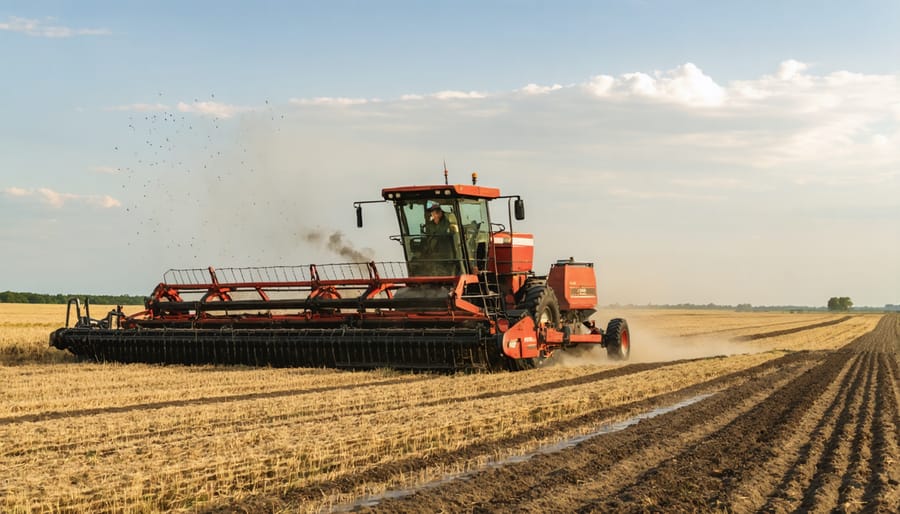
Equipment and Techniques
Several reliable tools are available for applying biochar effectively across your fields. For larger operations, modified manure spreaders and fertilizer broadcasters work well, especially when biochar is mixed with compost or other amendments. Many Alberta farmers have found success using conventional grain drills with slight modifications to prevent clogging.
For smaller plots, push-type lawn spreaders offer good control over application rates. Hand-spreading is viable for garden-sized areas, though wearing a dust mask is recommended. To ensure even distribution, consider mixing biochar with sand or existing soil at a 1:1 ratio before spreading.
Pre-moistening your biochar can significantly reduce dust and improve handling. A light misting with water (15-20% moisture content) helps the material flow more smoothly through equipment. For precision application, consider using GPS-guided systems, particularly common in central Alberta’s larger operations.
Remember to calibrate your equipment before full-scale application. Start by testing your chosen spreader on a small area, measuring actual coverage against intended application rates, and adjusting accordingly.
Real Results: Alberta Case Studies
Central Alberta Grain Farm
A compelling example of biochar’s effectiveness comes from the Larson Family Farm, located 30 kilometers east of Red Deer, Alberta. In 2021, the farm conducted a controlled trial across 40 hectares of wheat fields, applying biochar at varying rates to test its impact on soil water retention.
The most successful results came from plots treated with 10 tonnes per hectare of biochar, showing a 27% increase in water holding capacity compared to untreated areas. During the unusually dry summer of 2022, these treated sections maintained soil moisture levels significantly longer than control plots, resulting in a 23% higher yield.
“We noticed the difference especially during the three-week dry spell in July,” says Sarah Larson, who documented the trial results. “Fields with biochar required two fewer irrigation cycles, saving both water and operating costs.” The farm’s success with biochar water filtration benefits has inspired neighboring farms to implement similar practices.
Soil testing revealed that plots with biochar maintained optimal moisture levels for 8-10 days longer after rainfall events compared to untreated areas. The Larsons have since expanded their biochar application to cover 75% of their cropland, reporting an estimated annual water savings of 2.3 million liters across their operation.
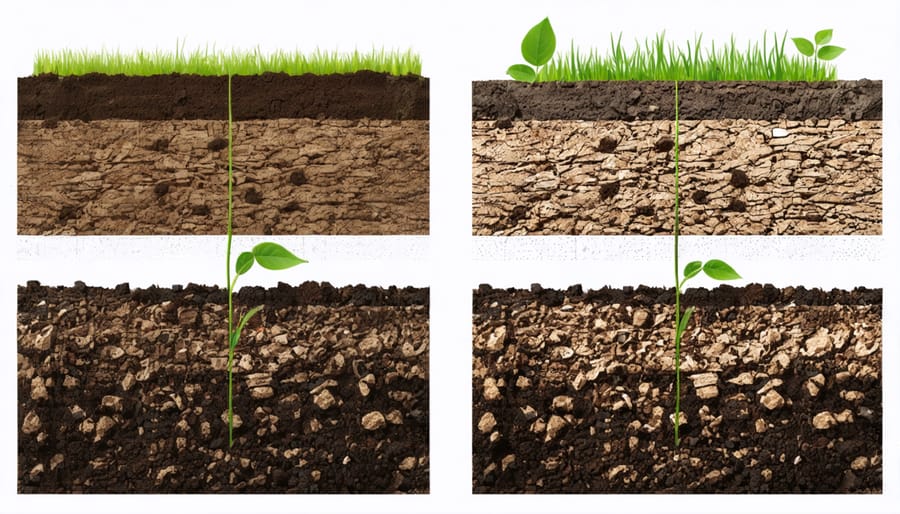
Southern Alberta Market Garden
In 2021, Sarah and John McKenzie’s market garden operation near Lethbridge demonstrated remarkable success with biochar implementation across their 5-hectare vegetable production. Working with local agricultural extension services, they applied biochar at a rate of 10 tonnes per hectare, incorporating it into their sandy loam soil during spring preparation.
The McKenzies carefully documented their experience, noting a 30% reduction in irrigation needs during the typically dry southern Alberta summer. Their tomato and pepper crops showed particular resilience during the July heat waves, maintaining productivity with less frequent watering compared to previous seasons.
“We mixed the biochar with our regular compost before application,” explains Sarah McKenzie. “This pre-charging method helped us achieve faster results, especially in our heavy-feeding crops like squash and cabbage.” Their application strategy involved initial deep incorporation using a rotary tiller, followed by shallow cultivation to maintain an even distribution in the top 20 centimeters of soil.
Cost analysis showed that while the initial investment was significant at approximately $2,000 per hectare, the reduction in irrigation costs and improved crop resilience provided a positive return within two growing seasons. The McKenzies also reported improved soil structure and reduced wind erosion, common challenges in the southern Alberta region.
Local agricultural extension officers now use the McKenzie’s market garden as a demonstration site for other small-scale farmers interested in biochar application.
As we’ve explored throughout this guide, successful biochar application in Alberta’s diverse agricultural landscape depends on thoughtful planning and proper implementation. The recommended application rates of 5-20 tonnes per hectare have shown promising results across various soil types, with many local farmers reporting improved water retention and crop yields within the first growing season.
Remember that your specific situation – including soil type, crop selection, and local climate conditions – will influence your optimal application rate. Start conservatively, perhaps with 5-10 tonnes per hectare, and monitor your results. Many successful Alberta farmers have found that incorporating biochar gradually allows them to fine-tune their approach while managing costs effectively.
The investment in biochar application today represents a long-term commitment to soil health and sustainable farming practices. With proper application methods and careful monitoring, you’re not just improving your soil for the next harvest – you’re building a legacy of healthy, productive farmland for generations to come.
Consider connecting with local agricultural extension services and fellow farmers who have experience with biochar application. Their practical insights can be invaluable as you begin your biochar journey. The growing community of biochar users in Alberta continues to demonstrate that this soil amendment strategy can be both environmentally and economically beneficial when applied thoughtfully and systematically.
Take that first step toward improved soil health – your land and future harvests will thank you for it.

